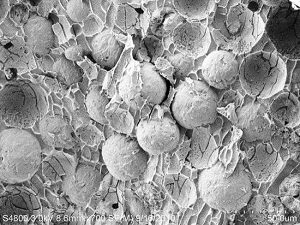Smithsonian Highlights C-MEDS Search for Safer Dispersants
– April 14, 2015
Responders to the Deepwater Horizon oil spill used nearly two million gallons of dispersant to assist biodegradation and prevent shoreline oiling.
This unprecedented dispersant use, in quantity and location, has stimulated scientific research for environmentally benign and effective alternatives.
The Smithsonian published an article featuring C-MEDS research into nanoparticles as potential replacements or supplements for commercially-available dispersants. This research is a part of the larger C-MEDS effort to understand dispersants and their chemical compounds’ roles in mitigating deep sea oil spills and designing next-generation dispersants.
Read the Ocean Portal article to learn about advances in nanoparticle technology for improved oil spill response.
For more information about C-MEDS dispersant-related research:
Read these summaries of peer-reviewed journal articles:
- Studies Show Carbon Black Particles as an Alternative or Supplement for Oil Dispersants
- Study Finds Ecofriendly Clay Delivers and Improves Oil Spill Treating Agents
- Study Identifies Efficient Food-Grade Emulsifier as Dispersant Alternative
Read these descriptions of ongoing C-MEDS research featuring GoMRI Scholars:
- Grad Student Saha Makes Strides towards an Eco-friendly Dispersant Alternative
- Grad Student Worthen Improves Oil Production and Cleanup Using Nanoparticles
************
GoMRI and the Smithsonian have a partnership to enhance oil spill science content on the Ocean Portal website.
This research was made possible in part by a grant from BP/The Gulf of Mexico Research Initiative (GoMRI) to the Consortium for the Molecular Engineering of Dispersant Systems (C-MEDS). The GoMRI is a 10-year independent research program established to study the effect, and the potential associated impact, of hydrocarbon releases on the environment and public health, as well as to develop improved spill mitigation, oil detection, characterization and remediation technologies. An independent and academic 20-member Research Board makes the funding and research direction decisions to ensure the intellectual quality, effectiveness and academic independence of the GoMRI research. All research data, findings and publications will be made publicly available. The program was established through a $500 million financial commitment from BP. For more information, visit https://gulfresearchinitiative.org/.
© Copyright 2010- 2017 Gulf of Mexico Research Initiative (GoMRI) – All Rights Reserved. Redistribution is encouraged with acknowledgement to the Gulf of Mexico Research Initiative (GoMRI). Please credit images and/or videos as done in each article. Questions? Contact web-content editor Nilde “Maggie” Dannreuther, Northern Gulf Institute, Mississippi State University (maggied@ngi.msstate.edu).






